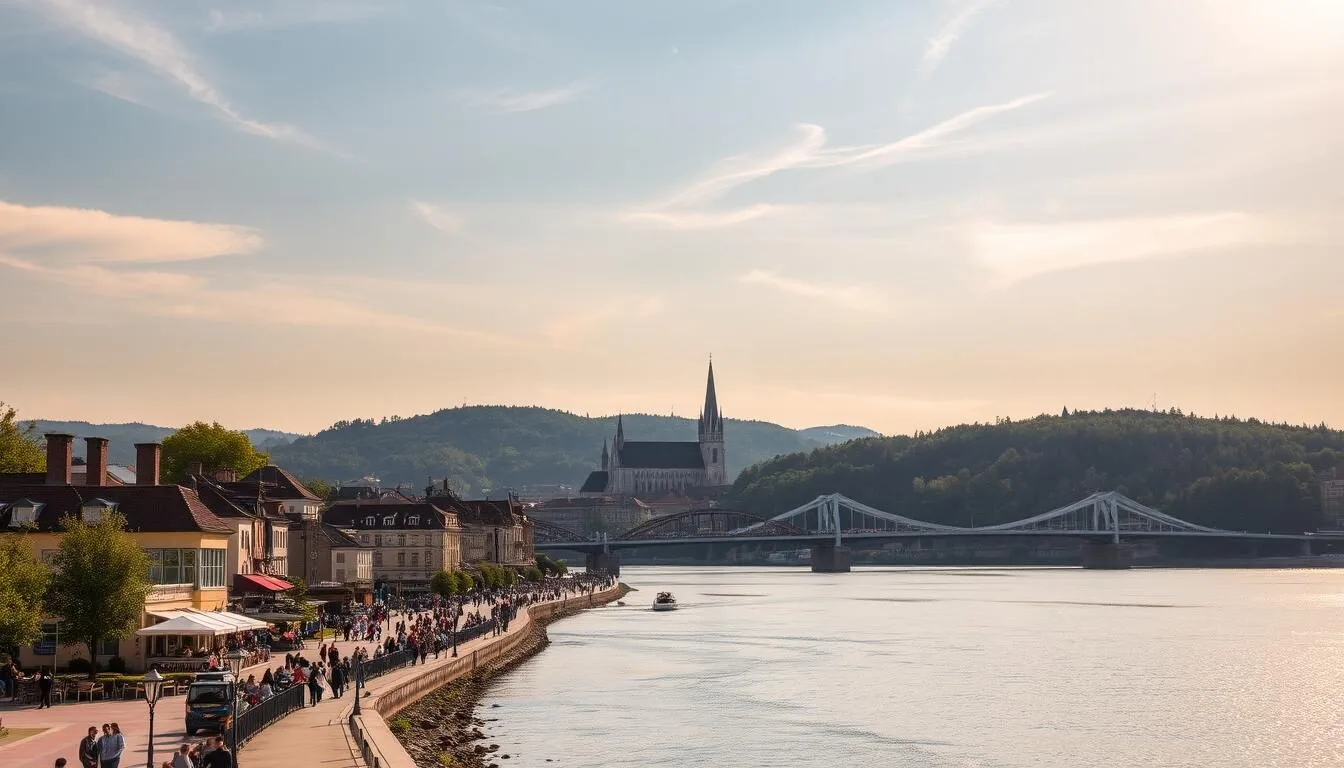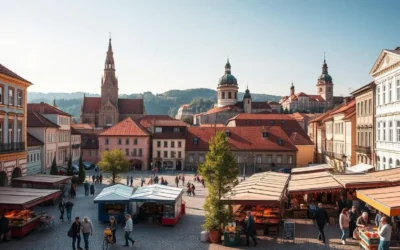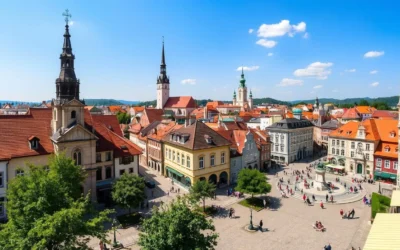Surprising fact: this small city scores about 37/100 for “Worth it?/Infrastructure,” ranking roughly 2,936 of 3,028 cities in 2025.
You should know up front that this destination has limited activities and a compact dining scene. The main draws are riverfront walks, industrial heritage, and striking modernist architecture.
Plan for a short visit or a day trip from Budapest. Focus on a few quality attractions like the Intercisa Museum and notable facades rather than trying to fill an exhaustive itinerary.
Who will enjoy it? Curious visitors who like architecture, history, and calm Danube time will get the most from this travel stop. Practical tips and a realistic list of top experiences follow so you spend more time exploring and less time searching.
Why this city should (or shouldn’t) be on your radar right now
This compact river city rewards visitors who enjoy honest, industrial-era streets and quiet riverside time. Its modernist facades and curated museums tell a recent history rather than centuries of layered past.
The practical side: it ranks low for tourist infrastructure and has limited restaurants, nightlife, and guided tours. If your idea of a perfect travel destination includes buzzing entertainment and many sites, you may be disappointed.

- You should consider it if you value a calm atmosphere, clear industrial story, and easy logistics for a short visit.
- You shouldn’t consider it if you want a packed schedule of attractions or a lively foodie scene.
- You’ll appreciate learning about the recent past through streetscapes and small museums rather than grand palaces.
- You’ll be comfortable here if you plan around limited visitor services and enjoy self-guided exploration.
In short, treat this as a focused, characterful stop. With modest expectations, the overall experience can be quietly rewarding and different from typical Central European city breaks.
Dunaújváros, Hungary: Best Things to Do – Top Picks
Start with a riverside walk and let the town’s clean lines and museums set your pace. The danube riverbank is the single best place for fresh air, easy views, and a relaxed itinerary that suits a half-day or a full day trip from Budapest.

Walk the riverbank for views and fresh air
You’ll make the riverwalk your anchor. It combines greenery, breezy spots, and low-effort activities you can do at your own pace.
Explore the Intercisa Museum for local history
Plan one focused stop at Intercisa. This museum delivers efficient context on local culture and heritage so you get more from fewer attractions.
Spot modernist architecture across the center
You’ll scan the center for clean modernist facades and socialist-era details. Architecture and public art are compact and readable in a single afternoon.
Take a short day trip from Budapest
Consider self-guided routes rather than formal tours, since guided offerings are limited. Fold in a café break to absorb daily life, then move on with calm expectations.
| Activity | Why it’s worth it | Time needed |
|---|---|---|
| Danube riverbank walk | Best mix of views, greenery, and low-effort relaxation | 30–90 minutes |
| Intercisa Museum | Concise local history and artifacts in one stop | 45–60 minutes |
| Architecture stroll | Modernist facades and public art in the city center | 30–60 minutes |
Plan smart: How to enjoy a limited-attractions city
Smart timing and simple plans turn a compact destination into a relaxed win. With attractions spread out and guided tours scarce, you’ll get more from less by focusing on a tight route and a clear schedule.

Bundle close-by sights to save time
You’ll cluster nearby sites—riverbank segments, central architecture, and the Intercisa Museum—so you spend more time enjoying and less time walking between far-flung spots.
Lean on self-guided walks when tours are scarce
Use offline maps, a short checklist, and saved pins. Self-guided activities are the most reliable option when local tour support is limited.
- Pre-plan meals and pick a backup café since dining options are modest.
- Set a clear start and finish window so your time fits return transport.
- Carry small cash and cards, and set a realistic price expectation—no big splurges needed.
- Download a short list of practical ideas and a simple map for quick reference.
Tip: rely on apps and notes you already use for traveler support rather than hunting for local desks that may not exist. This keeps your day calm, efficient, and enjoyable.
One perfect day in Dunaújváros: a practical itinerary
Spend a focused day moving from modernist streets to a calm riverside sunset. This plan covers the main attractions in sensible time and keeps your schedule flexible.
Morning: architecture highlights and a coffeeshop break
Start with a relaxed walk through the city center, spotting modernist facades and public art. Grab coffee at a local café to catch everyday rhythms and recharge for the day.
Afternoon: Intercisa Museum and Danube stroll
Head to Intercisa by late morning for a concise museum visit that anchors local history. Keep lunch simple and nearby—limited dining means less time hunting and more time exploring.
After lunch, dedicate the afternoon to the Danube riverbank. Choose a scenic stretch for photos, easy walking, and low-effort relaxation.

Evening: casual dinner and riverside sunset
Reserve a casual spot in advance when possible. Aim for a classic dish so you try local flavors without wasting time traveling across town.
Cap the day with a slow riverside walk and a sunset view, then head back to your transport on a calm note.
- Quick ideas: plan dinner ahead, carry small cash, and add a little schedule buffer.
- Why it works: compact activities keep the day efficient and enjoyable.
Architecture lovers’ route: modernist facades and public spaces
Follow a compact route that highlights mid-20th-century facades and thoughtful civic planning.
You’ll map a short loop through the center to see signature lines, symmetry, and public plazas that define this era.
Pause at civic buildings, residential blocks, and public art to compare materials and functions. These sites show how the planned-city approach from the 1950s shaped streets and access.
- Contextualize the walk with a quick primer or museum notes so the history behind facades becomes clear.
- Notice green spaces and wide avenues; they reflect a different heritage than older European centers.
- Look closely at tiles, reliefs, and signage—small details reveal the design language of the century more than any single landmark.
Keep the route manageable and central. You don’t need to range far to appreciate the architecture and the civic intent that still guides the city’s look today.
Industrial past, present vibe: understanding the city’s atmosphere
The city wears its industrial roots openly—this shapes how streets, parks, and daily life feel.
Originating as a steel-production hub in the mid‑20th century, the local history is recent compared with older regional centers. That era left a practical plan: wide avenues, open plazas, and functional civic buildings instead of narrow, ornate lanes.
You’ll see how the mid‑century push created an atmosphere that is more honest than polished. The vibe favors work rhythms and utility, and that shows in everyday life and public space.

People here are straightforward and welcoming. The local culture reflects industry and pride rather than tourism flair. That gives visitors a clear sense of place, even if beauty looks different from a medieval town.
- You’ll connect the recent past to daily routines and civic design.
- You’ll notice modern fabric compared with older centuries-old regions.
- You’ll leave with a balanced view: authenticity is strong, but the heavy-industry feel may not suit every traveler.
Outdoors & Danube moments: light hiking, biking, and river walks
If you want fresh air and simple views, the Danube paths are the most rewarding option in town.
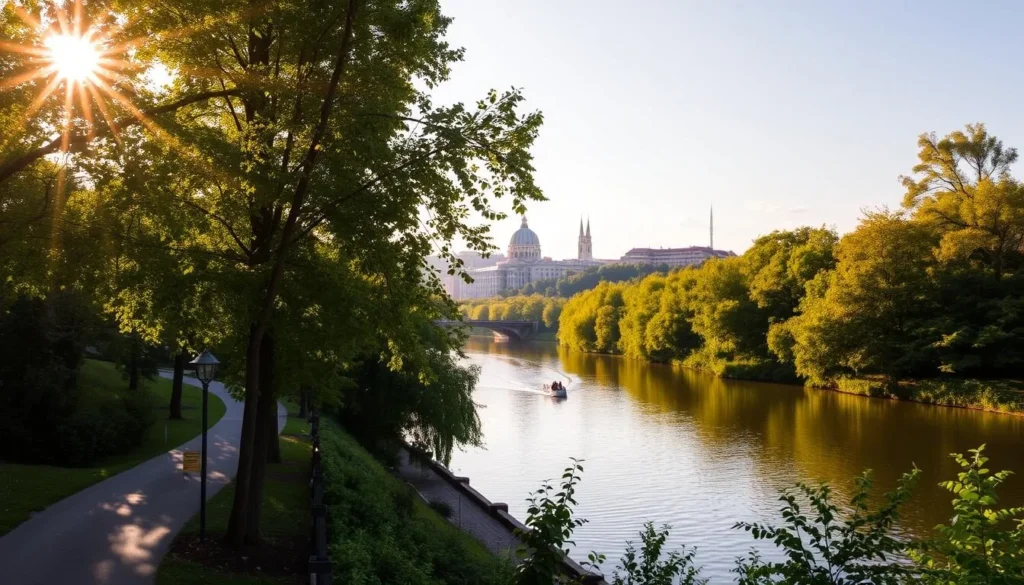
Outdoor opportunities center on the riverbank, where flat paths make casual walking and cycling the easiest ways to enjoy the water.
Best riverside segments to wander
You’ll plan your outdoor time around a couple of nicest stretches so your activities feel intentional rather than aimless. Pick one upstream and one downstream segment and use cafés as natural rest stops.
Bring a picnic or coffee and treat the river as your day’s scenic anchor. Return at golden hour for softer light and calm photo moments.
- You’ll opt for light biking if you want to cover more ground without complex logistics.
- You’ll keep expectations modest: this is low-key fresh-air time, not long trail networks or high-adrenaline hiking.
- You’ll use the riverside to balance a museum or architecture visit with relaxed outdoor beauty.
Culture check: museums, galleries, and community events
Check the cultural map early: museums and small galleries give the clearest sense of local life. Intercisa Museum is the main anchor for history and context, so make it your first stop.
You’ll layer in any nearby art and public installations as you walk. Summer brings more community events and small festivals, so check local listings if you visit then.
Keep your plan short and flexible. Opening hours and offerings can vary, and the number of cultural sites is small. Use café pauses to soak in rhythm—sitting and watching often reveals more than a guided schedule.
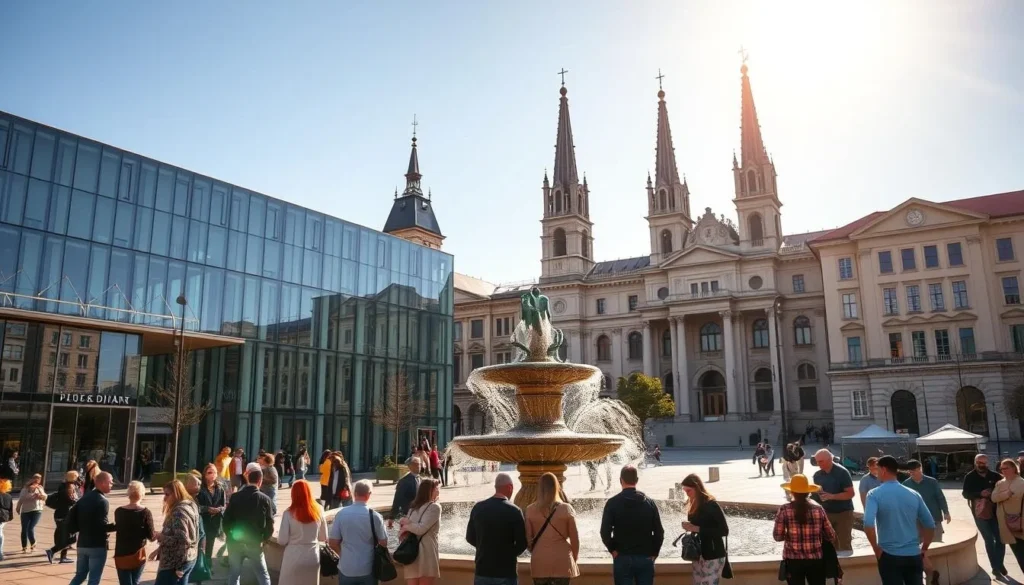
- You’ll treat Intercisa as your cultural anchor, then add galleries or public-art stops you spot.
- You’ll check for summer events that boost local activities and visitor energy.
- You’ll include a food moment—try a traditional dish and notice paprika on menus to link cuisine and culture.
Treat this as a gentle cultural dip rather than a deep dive. You’ll leave with a handful of grounded experiences that show daily life without needing heavy bookings.
Food & drink: what to try and where to find it
Meals in this city tend toward comfort dishes and casual cafés rather than trend-driven dining. Expect simple menus and honest cooking. Plan mealtimes around a short list of options so you aren’t caught searching when places close.
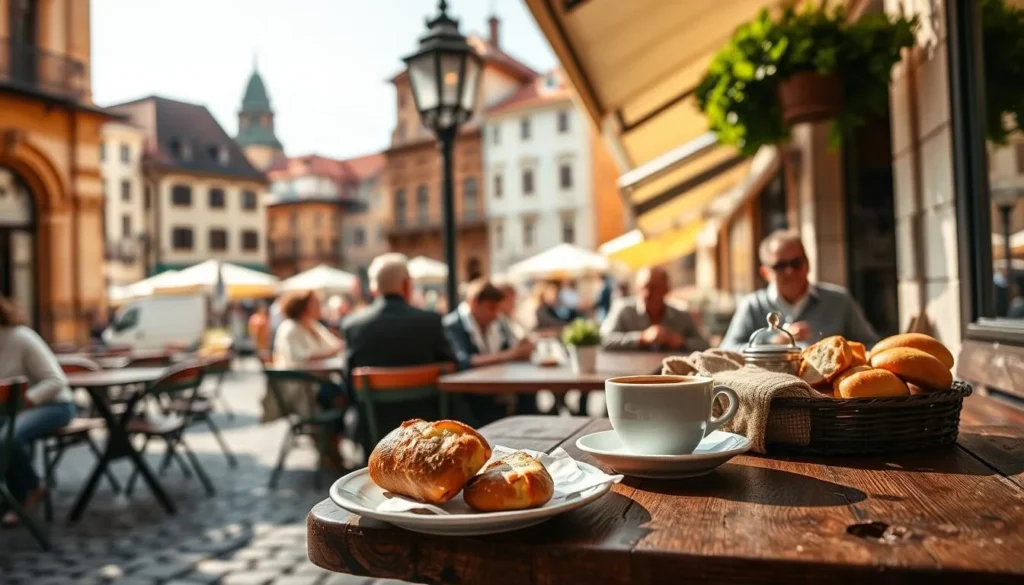
Hungarian staples worth ordering
You’ll aim for classic dishes: gulyás, töltött káposzta, lángos, and paprikás csirke. These are the easiest items to find and show the local flavor.
How to navigate a sparse dining scene
There are roughly 85 restaurants and about 170 food or drink places total. That means choices exist, but variety is limited.
- Pick one café and one sit-down spot near your route to avoid long detours.
- Plan dinner near the river or center for convenience rather than hunting across town.
- Expect straightforward kitchens rather than elaborate menus.
Vegetarian and seafood options: what’s realistic
About seven vegetarian-focused spots operate locally. Flexible vegetarians can combine salads, soups, and sides for a full meal.
Seafood appears at roughly 25 places, usually in simple preparations. If you want specific items, call ahead.
| Category | Availability | What to expect |
|---|---|---|
| Classic Hungarian dish | High | Comfort cooking, paprika-forward flavors |
| Vegetarian options | Low (~7 dedicated) | Salads, soups, adaptable plates |
| Seafood | Moderate (~25 places) | Simple fish dishes, casual prep |
Souvenirs and local products: small but meaningful finds
You won’t find many dedicated souvenir boutiques, but useful keepsakes are still around. Look for items that capture local heritage and culture without requiring a long shopping hunt.

Paprika tins, embroidered textiles, and small handcrafted woodwork make the best mementos. These pieces are easy to pack and say something genuine about the region and its craft traditions.
Paprika, textiles, and handcrafted woodwork
Pick compact spice tins or blended mixes that travel well. Tea towels, small embroidered items, and modest wood carvings show local art and function at home.
Where to look when dedicated souvenir shops are limited
Browse general stores, museum shops, and market-style outlets instead of expecting many boutiques. Ask café staff or shop attendants for leads—local people often know where regional goods appear.
- You’ll focus on easy-to-pack items like paprika tins and small woodwork reflecting Hungarian heritage.
- You’ll browse museum shops or general stores because dedicated souvenir spots are scarce.
- You’ll choose pieces that showcase craft and art traditions rather than mass-produced goods.
- You’ll keep expectations modest and aim for one or two meaningful mementos.
- You’ll consider practical ideas—spice blends, tea towels, or small posters—that get used at home.
When to visit: quieter months, busier seasons, and weather tips
Timing your trip makes a big difference for crowds, light, and outdoor comfort. Aim for shoulder seasons if you want calmer streets and easy walking. Pick summer if you prefer longer days and a few local events.
Early spring and late autumn for mild, crowd-free exploring
You’ll find early spring and late autumn the calmest months with mild weather and fewer visitors. Museum visits and river walks are more peaceful then.
Dress in layers. Mornings can be cool and afternoons warm, so bring a light jacket and breathable layers.
Summer events and Danube-side days
If you want livelier energy, choose summer for community events and long daylight. The danube river is at its most pleasant on warm, still days.
Check local forecasts and align your river plans with clear weather. For the best photos and the most charm, plan walks around golden hour when the light shows the river’s beauty.
- Quick tip: pair a visit here with time in the capital when the forecast looks rainy, and save outdoor days for clear skies.
Budgeting your visit: prices, value, and where to spend
A modest budget stretches far here if you plan where to spend and where to save.
Most of your cost will go to transport, a simple meal, and a museum ticket. Many attractions are free or low-cost, so the daily price stays reasonable.
Plan smart: favor self-guided walks and river time for low-cost activities. Pack water and a small snack to avoid extra stops when options are limited.
- You’ll budget primarily for transport, a museum ticket, coffee/snacks, and one casual meal.
- You’ll set aside a small extra amount for a sit-down lunch or dinner to anchor the day.
- You’ll rely on travel support tools you already use—maps, notes, and saved places—rather than paid add-ons.
Use timing as a cost saver: cluster nearby activities to cut transit time and incidental spending. This keeps your visit efficient and lets you enjoy more for less.
| Expense | Typical cost (est.) | Why it matters |
|---|---|---|
| Transport (round-trip local) | $6–$25 | Primary unavoidable spend; depends on mode and season |
| Museum ticket (Intercisa) | $3–$8 | Provides local context; good value for time spent |
| Meal + coffee | $8–$25 | Casual dining options; choose one sit-down to relax |
| Snacks & water | $2–$6 | Prevents time loss and extra café visits |
Where to stay: hotels vs. vacation rentals, and why to book early
A well-located base near the river or center turns limited attractions into a smooth, enjoyable visit.
Accommodation inventory is small: roughly 15 serviced options and about 25 vacation rentals. Book early, especially for summer weeks, because choices fill fast.
Why location matters: staying central or river-adjacent cuts transit time and keeps key sights walkable. You’ll trade flashy amenities for quiet rooms, reliable Wi‑Fi, and easy access to the core experiences.
- You’ll book early since the pool of hotels and rentals is tight during peak weeks.
- You’ll choose a central or riverside stay to shorten walking routes and save time.
- You’ll pick basics—quiet, proximity, good Wi‑Fi—rather than luxury features that are rare here.
- You’ll stay flexible with dates to unlock better options in this small destination inventory.
- You’ll read recent reviews for check-in ease and noise levels; those details matter when options are few.
| Type | Approx. count | When to choose |
|---|---|---|
| Serviced hotels / guesthouses | ~15 | When you want simple check-in and basic amenities |
| Vacation rentals | ~25 | Good for families or longer stays with a kitchen |
| Day-trip option | N/A | Consider a one-night stay only for a slow evening by the water; otherwise a day trip often suffices |
Getting there from Budapest and getting around town
A quick rail or car ride from the capital makes a day trip simple and satisfying.
Plan an early departure so you have a full day for the museum, architecture, and the danube riverbank. Public transport runs, but services are uneven. That means you’ll want to build a walkable route around central sights.
Best day-trip logistics and transport expectations
Travel by regional train or car if you prefer flexibility. Trains offer a low-cost option, while driving lets you set the schedule.
Local buses exist, but frequency drops outside peak times. You’ll rely on walking between main spots and plan your return using saved timetables.
- Leave early: more daylight and easier return options.
- Keep it central: base your route on the museum, main facades, and riverbank.
- Skip formal tours: organized tours are limited, so self-guided exploration works best.
- Check schedules: save last-ride times to avoid a rushed exit.
- Pack light: water, a light jacket, and a power bank keep you mobile and comfortable.
| Option | Typical time | Flexibility |
|---|---|---|
| Regional train | 60–90 minutes from the capital | Moderate — set schedules, reliable but infrequent |
| Car | 40–70 minutes depending on traffic | High — you control arrival and departure |
| Local bus (within town) | Short hops, 10–30 minutes | Low — infrequent off-peak runs; best for short legs |
Final tip: stay flexible and focus on core destinations you can comfortably walk between. That approach keeps the day calm, efficient, and enjoyable.
Working on the road: Wi‑Fi, coworking, and digital nomad realities
Remote work here requires simple planning: reliable connections, quiet spots, and a tested backup plan. Expect enough infrastructure to get things done, but don’t treat the town like a major nomad hub.
Connectivity expectations and eSIM tip
There are roughly 110 public Wi‑Fi spots, and average speeds near 40 Mbps down / 25 Mbps up. That is usually fine for video calls and cloud tasks, but confirm your accommodation’s speed before you book.
Bring an eSIM or local data plan so you can move between cafés and the river without losing a call. Use the eSIM as primary backup for meetings while you travel; it gives steady mobile uplink when public Wi‑Fi falters.
Quiet focus vs. limited community
You’ll find about four coworking or short-term office options. Book ahead if you want guaranteed desks and quiet time.
- You’ll be able to get work done with average speeds around 40/25 Mbps, but confirm room speeds first.
- You’ll bring an eSIM or local data plan as backup for calls when you move between activities.
- You’ll expect a quiet-focus environment rather than an active nomad network; community events are sparse.
- You’ll keep your setup lean—laptop, headset, charger—and pick cafés with outlets over ambiance.
| Item | Count / Speed | Why it matters |
|---|---|---|
| Public Wi‑Fi spots | ~110 | Good coverage for short work sessions |
| Coworking / desks | ~4 | Reserve if you need quiet, reliable space |
| Average internet | 40/25 Mbps | Sufficient for most remote work tasks |
If you need occasional support while online, plan calls for before or after museum time. This rhythm fits the calm riverside world and the light travel pace here.
Pros and cons at a glance: set expectations the right way
Quickly weigh what you want from a short stop—architecture, history, or a riverside pause.
Overall score ~37/100 reflects a low density of activities, restaurants, and nightlife. That gives you a calm, honest visit rather than a bustling trip.
- Why you’ll like it: industrial history, clean modernist architecture, compact art and culture spots, close proximity to Budapest, and plenty of Danube outdoor time.
- Why you might not: an industrial vibe, limited tourist infrastructure, small size, and less deep historical layering than older regional centers.
- For visitors: pick this destination if your top priorities are a quiet atmosphere, design-focused walks, and a short, focused experience by the river.
You’ll find the trip works best when you plan a compact route, pre-choose a meal stop, and allow extra time for river light and photos. If you expect dense attractions, buzzy nightlife, or heavy shopping, you’ll likely be underwhelmed.
| Aspect | Strength | Quick action |
|---|---|---|
| History & architecture | Industrial story and modernist facades | Follow a short walking loop in the center |
| Outdoor options | Danube riverbank walks and easy biking | Save golden hour for photos |
| Visitor services | Limited restaurants and nightlife | Book a meal ahead and bring snacks |
| Size & feel | Compact, honest atmosphere | Plan a half-day or day-trip, not a long stay |
Conclusion
Think of this as a short, curated travel destination where a few well-chosen stops give the clearest return on your time. Plan a museum visit, an architecture stroll, and a riverside break rather than a long checklist.
You’ll leave with tidy, meaningful experiences and a sharper sense of 20th‑century design and industrial history. Spend time with the Intercisa Museum notes and the clean facades for the best context.
You’ll also remember the simple beauty of unhurried river moments and how local people use public space. Keep meals easy and nearby so cuisine fits the day without fuss.
Arrive open-minded and brief, and this quiet corner of the world will add a clear, calm chapter to your travel life.
The above is subject to change.
Check back often to TRAVEL.COM for the latest travel tips and deals.
